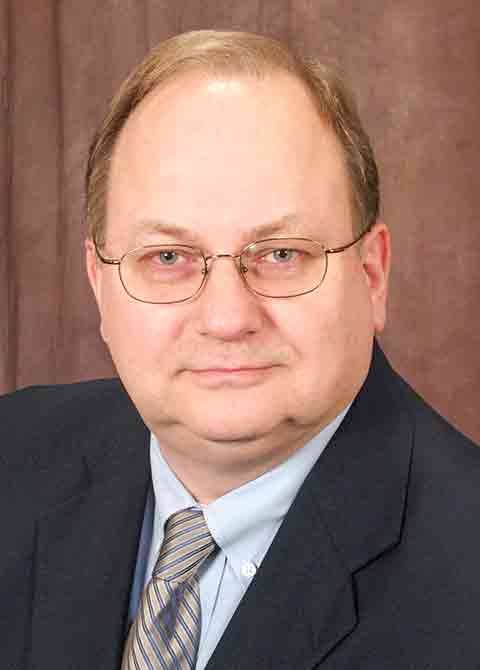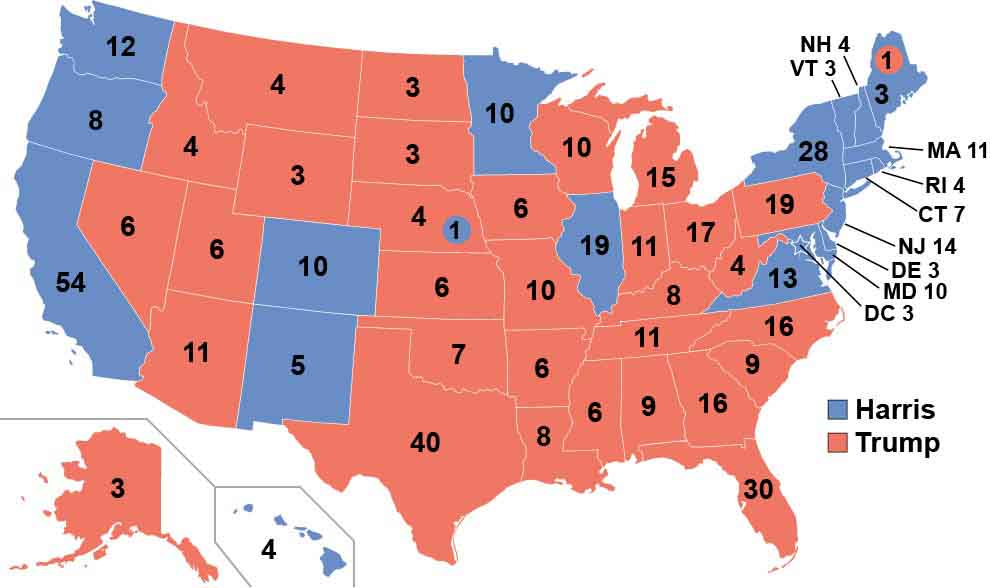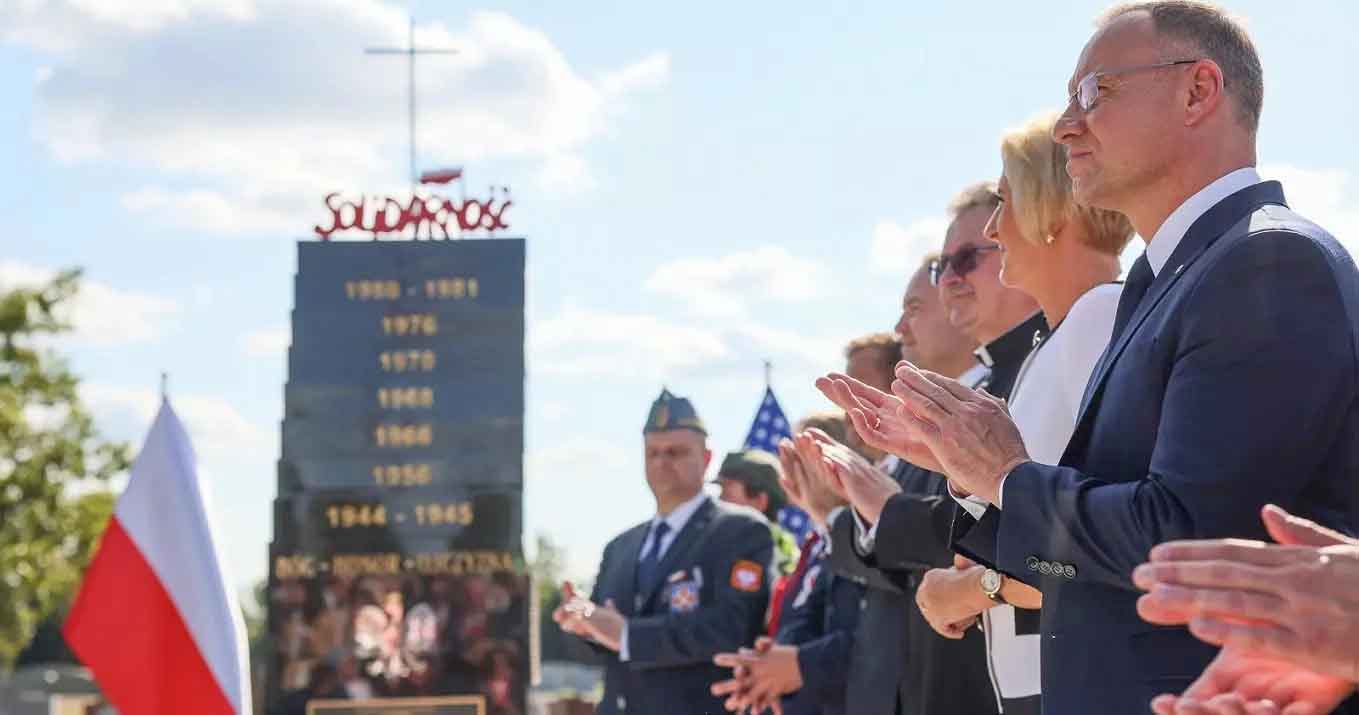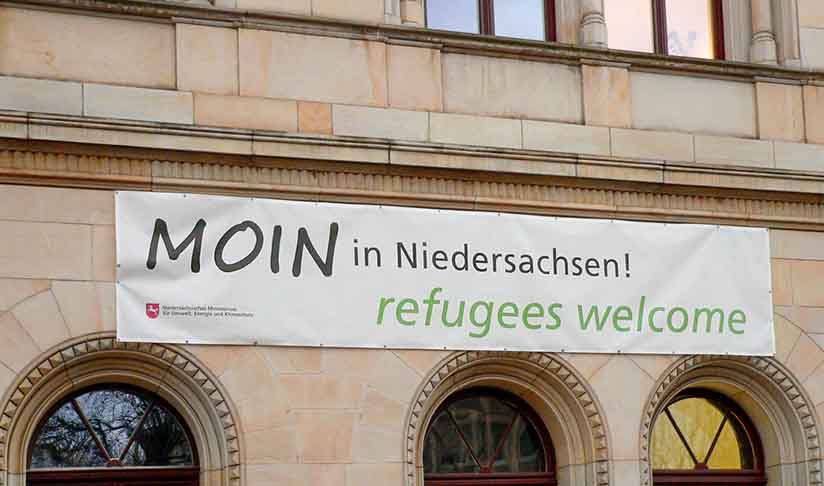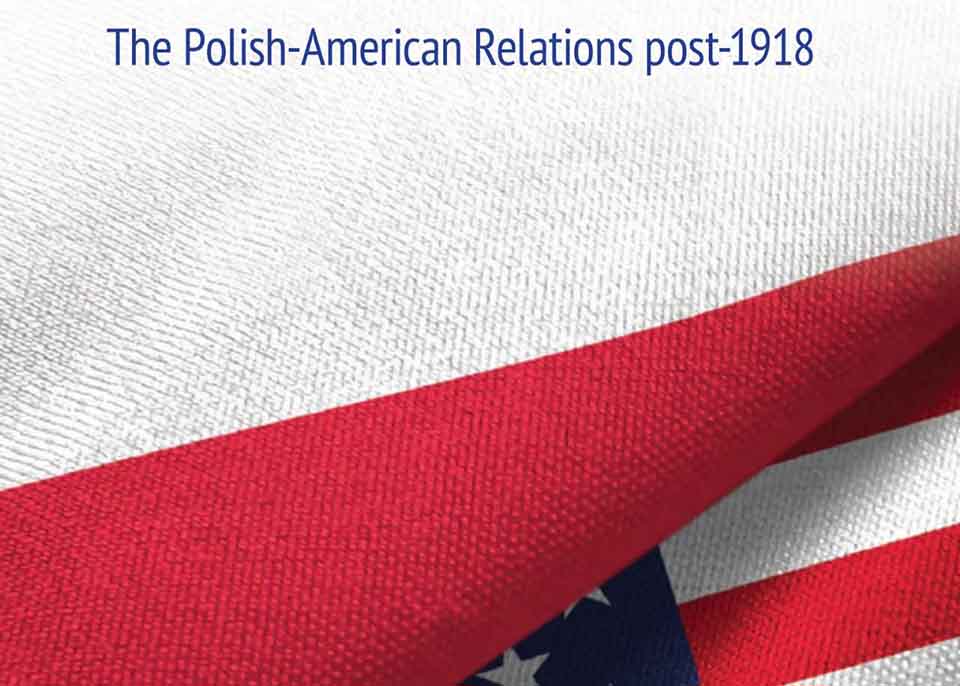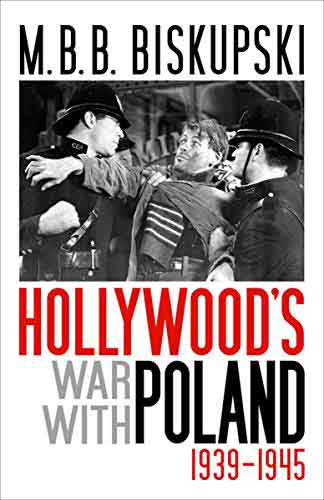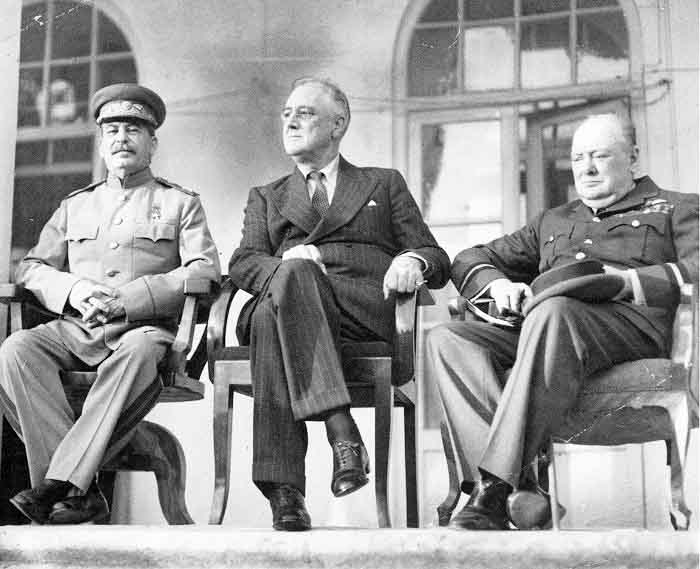There Is a Photo Like This
There is a forgotten photo from a meeting of delegates of the newly established Polish American Congress with US President Franklin D. Roosevelt. It took place on October 11, 1944. It may illustrate how the Polish American community was and is manipulated by the US administration. The photo shows
on the wall of the Oval Office in the White House a map of the Republic of Poland in its pre-war borders, which was meant to suggest – and was received as such – that the United States recognized this territorial shape of the Polish state. Meanwhile, a year earlier Roosevelt had agreed to Stalin's proposal to base the Polish-Soviet border on the Curzon Line.
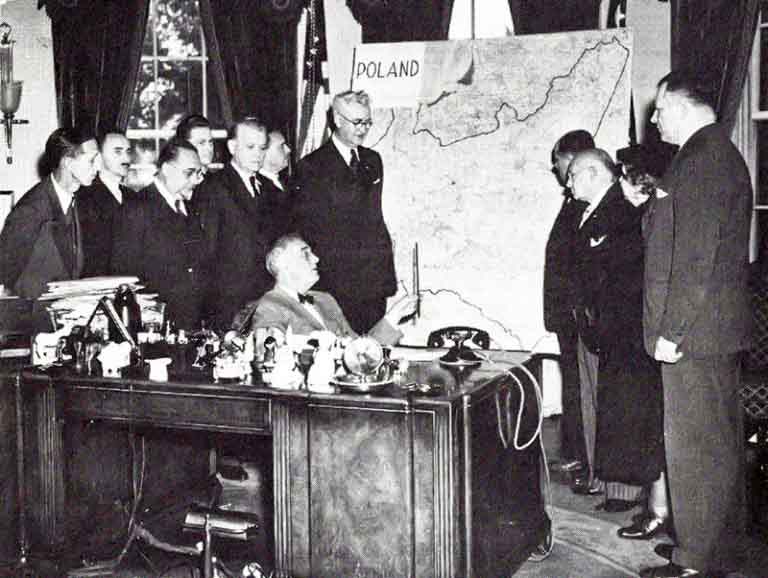
FDR and the Polish American Congress delegation, 1944 (Source: Polish American Congress)
In this way, FDR deceived 6 million American Poles who voted for him in the elections of November 7, 1944.
In a later statement, President Roosevelt announced on December 14, 1944, that the United States had no objections to the new location of Polish borders. President Karol Rozmarek (born July 25, 1897 in Wilkes-Barre, Pennsylvania, graduated from Harvard Law School) then called on six million Poles living in the United States to "flood" the White House with letters and telegrams in protest against the Soviet plunder of Polish lands. Although Polonia supported Roosevelt's New Deal, or state interventionism in the fight against the Great Depression, portraits of President FDR disappeared from the walls of many American Polish homes.
The leaders of the Polish American Congress were cynically deceived by him. Polish diplomacy did not work, and pro-Soviet propaganda effectively blocked any manifestations of promoting the Polish raison d'état. In November 1944, Roosevelt was elected to a fourth term by a small majority of votes. The key to this victory was the votes he received from 90 percent of the Polish community, who did not know his real position on Poland.
At another summit meeting in Yalta in February 1945, Roosevelt, Churchill, and Stalin agreed to establish a Soviet-dominated Polish provisional government, which Roosevelt later defended upon his return to Washington. The then-president of the Polish American Congress, Ignacy Karol Rozmarek, condemned the Yalta agreement regarding Poland as a rejection of the Atlantic Charter.
By 1947, Stalin had managed to establish Poland as a Soviet satellite, which forced the PAC to continue its activities in defense of its rights to independence and democracy. The Polish press was censored not only in the United States, but in Great Britain and all allied countries. The Polish cause failed after the clear success of Jan Ignacy Paderewski and his personal influence on the then US President Woodrow Wilson, who effectively contributed to Poland regaining independence in 1918.

President Woodrow Wilson (Source: Wikipedia, Colorization: A. Woźniewicz)
Let us recall that on January 8, 1918, the President of the United States, Woodrow Wilson, delivered a message to the US Congress, the famous 13th point of which concerned Poland:
An independent Polish state should be created, which should include the territories inhabited by indisputably Polish populations, which should be ensured free and secure access to the sea, and whose political and economic independence and territorial integrity should be guaranteed by an international covenant.
This was also the position expressed at the Versailles Peace Conference, which lasted from January 18, 1919 to January 21, 1920. 27 victorious countries participated in it. Poland was represented by Ignacy Paderewski and Roman Dmowski.
The situation during World War II was different. Edwin O. Reischauer, historian and diplomat, wrote about it clearly:
There was a tendency in this country [the United States -ed.] to ignore Poland and deal with larger countries and those with which we had more dealings, as friends or enemies.
It was during this period that the most stupid Polish jokes were made, and the Warner Brothers film studio produced films in the spirit of social realism, presenting the less attractive themes of contemporary America, such as crime, poverty, and an incompetent legal system. In these films, Poles were portrayed as criminals and negative characters.
In one of these films, The Life of Jimmy Dolan, the villain was named Pulaski. In another film, How Many More Knights, the gangster and murderer was a man named Kościuszko. The Warner brothers were guests at the White House many times during the war for meetings with Roosevelt. Jack Warner described the production of pro-Soviet films such as Mission to Moscow and Air Force as morally inspiring. The brothers believed that they were contributing to the war effort. The whole process is described perfectly by Professor Mieczysław Biskupski (an American historian of Polish descent) in his book Hollywood's war with Poland, 1939-1945, Lexington, University Press of Kentucky, 2010.
But let's get back to FDR. Ludwik Stomma, a Polish cultural researcher and journalist, wrote that already in May 1942:
FDR told Deputy Secretary of State Adolph Berle directly that he would not particularly oppose the Russians taking over the disputed territories: they could take the Baltic republics and eastern Poland.
As Lynne Olson and Stanley Cloud write: FDR's reaction to the news about Katyn was mainly irritation. "The graves weren't worth all the fuss," he fumed. "What fools! I have no patience with them" [the Poles]. In a cable to the Soviet leader, he assured him that he "fully understood his problem." He believed that "the Poles were wrong," but he hoped that Stalin would not break off relations with them.
The administration of the US President Franklin Delano Roosevelt tried at all costs to present the USSR in a positive light. In this way, they wanted to justify in the eyes of public opinion the shaping of the post-war international order in cooperation with Moscow. It was therefore believed that the Katyn issue should not be raised in the diplomatic forum, despite the fact that there was information about the Soviet crime committed against Polish officers in 1940.
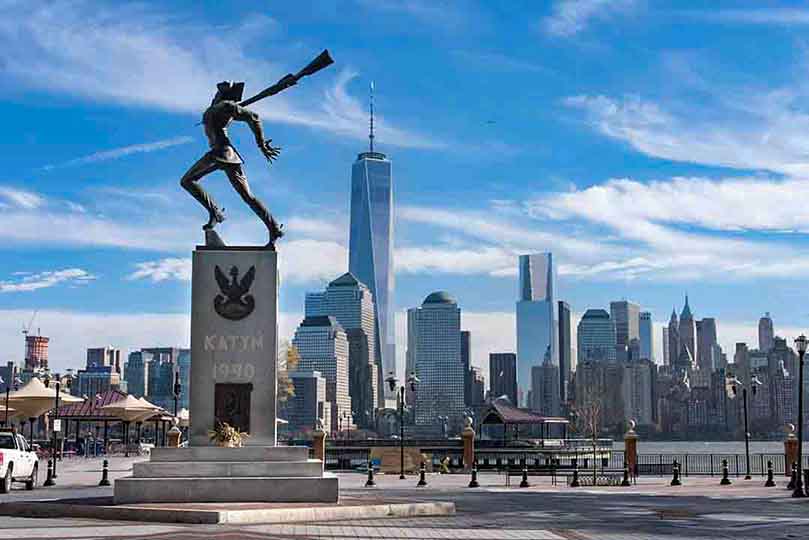
Monument to the Victims of Katyn in Jersey City by Andrzej Pityński (Source: KOPKiOH Archives)
It was not until 1951 that the United States House of Representatives established the Special Commission of Inquiry to Investigate the Facts, Evidence and Circumstances of the Massacre in the Katyn Forest, known as the Madden Commission after its chairman. By the end of 1952, the commission had conducted a meticulous investigation, collecting evidence and questioning over a hundred witnesses – in the United States, Great Britain, Germany and Italy. The following testified before the commission: Americans, Germans, Poles, Russians, Hungarians, Croats, Italians, Swiss, Danes and Swedes. The investigation resulted in the adoption by the House of Representatives of the final report, stating that the Soviet Union was responsible for the murder of Poles in Katyn in 1940. The work of the commission also revealed the mechanisms of concealing the truth about the Katyn crime in the United States.
"I saw Poland Betrayed"
Arthur Bliss Lane's memoirs were for years the foundation of the story of Poland and Poles betrayed by the Allies during World War II. Arthur Bliss Lane (1894-1956) was an American diplomat. In September 1944, he was appointed by President Franklin Delano Roosevelt as the US ambassador to the Polish government in London, but he never went to England to take up this post. Bliss Lane warned the Washington administration that Polish independence was at risk and that the United States should actively oppose the Soviets in its defense. Roosevelt replied, however, that he had full confidence in Stalin and did not want a confrontation with Moscow. The ambassador's position was not taken into account during the meetings of the Big Three in Yalta and Potsdam. The new president, Harry Truman, confirmed the nomination for Bliss Lane, who arrived in Warsaw in August 1945.
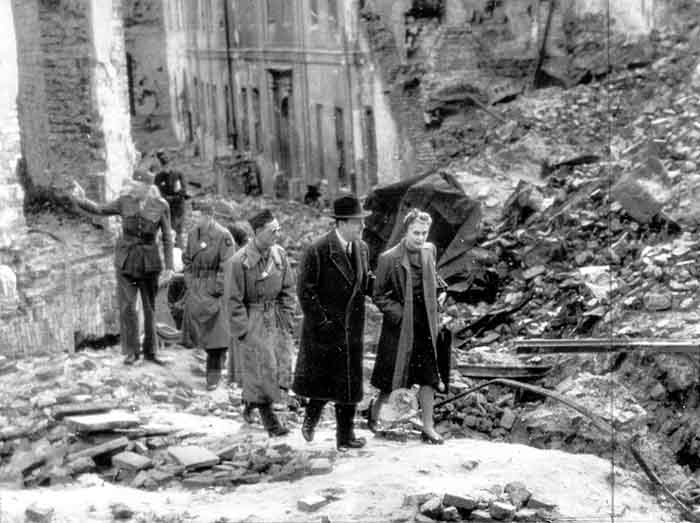
Ambassador Bliss Lane in Warsaw in 1945 (Source: Wikipedia)
While in Poland until February 1947, he documented the progressing Sovietization of the country. The ambassador wrote about the background of the anti-Jewish pogrom in Kielce, which he called a communist provocation. He sent reports to Washington proving that the elections to the Sejm in January 1947 were rigged. Disappointed with American policy in Central and Eastern Europe, after returning to the USA, he himself asked for resignation. He left diplomacy and took up journalism. In 1948, he published his memoirs entitled "I Saw Poland Betrayed" - one of the most important historical testimonies of that era. Until his death, he remained a great friend of Poland, sponsoring the magazine "The Polish Review" and publishing texts on Polish topics.
Conclusions
Not long ago I wrote a text in which the following phrase appears:
In November, the most important elections in the world will take place in the United States, which could change world history. However, as Poland, we have no influence on this, despite the fact that we have a 10 million diaspora in the US that could have a real influence on American policy. Officials in the State Department and other diasporas that work closely with it know this very well. The staff of Democrats and Republicans knows this. However, on the Vistula, we are in a position of attention. Waiting for new orders from Washington.
I wrote further:
It is worth remembering that the "rust belt", where the largest number of "swing states" are located - states that will tip the scales in the most important presidential elections in the world - is home to the largest number of 10 million Polish Americans, or 3% of the population of the United States, and they are the ones who can decide the outcome of these elections.
Yes, these are facts. The American Polish community is an unorganized political force that votes in elections. For many decades, American Poles have traditionally been the electorate of the Democratic Party. This has changed since the time of President Ronald Reagan. Joe Biden, in a New York Times article published on January 17, 2020, distanced himself from the American Polish community by saying: "We stopped showing up at the Polish-American club. We stopped showing up and we all went to you, the really smart people. We had a new kind of coalition that we were building. Women with higher education, students […] and so on," Biden explained. This can be understood directly: that the American Polish community has already played its role on the Democratic side and the time has come for young people educated at Marxist universities. The time of those who go to church and promote the teachings of Karol Wojtyła has passed. But has it really?
And yet. "Newsweek" says directly that Kamala Harris and Donald Trump are competing for the support of the influential Polish community, which may affect the outcome of the elections in the so-called "swing states". "Harris is trying to exploit the deeply rooted antipathy of the American Polish community towards Russia and Trump's reluctance to fully support Ukraine" - we read. In Michigan, there are about 784,000, in Pennsylvania 758,000, and in Wisconsin 481,000. The votes of the Polish community in the USA may tip the scales in the upcoming presidential elections. This is the opinion of American political analysts. "American Poles have every reason to vote for Trump even more in mass now than in 2016" - writes analyst William Ciosek on the pages of the renowned medium "American Thinker". In his opinion, the votes of the Polish community may prove to be crucial for Donald Trump's re-election in the November presidential elections.
The only question that remains is: who will mobilize Polonia? I will repeat my previous article in "Do Rzeczy":
No one is working with Polonia in this area, and the indicated directions of action are a folk image of Polonia, hołubce and pierogi. What is happening to the large Polonia organizations? They are discreetly extinguished or waiting for mythical guidelines from Warsaw, which never come.
Neither the Polish diplomacy, nor Polish politicians from the right to the left, nor publicists who learn about Polonia from the proverbial brother-in-law from Chicago are interested in American Polonia. They cannot even provide any simple facts about Polonia. They only repeat heard nonsense about a quarreling Polonia as if there was harmony in Poland and everyone from the right to the left was building the power and dignity of the Polish state.
There are still a few weeks left until November 5, 2024. Will any of the candidates make a direct appeal to the Polish community for support? Will the current Polish American Congress or the Polish-American Coalition make such an appeal for support for a candidate? Or will it happen again that we, as Polonia, will allow ourselves to be manipulated.



